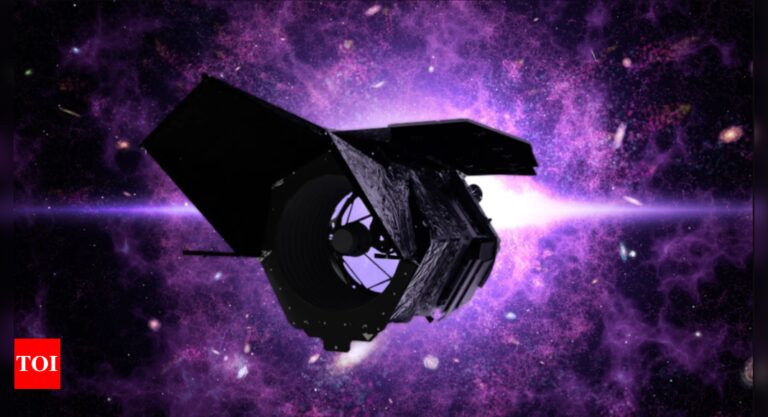
[ad_1]
NEW DELHI: Nasa‘s Nancy Grace Roman Space Telescope has successfully passed its initial optical test, marking a significant milestone in the assembly of the highly anticipated observatory. Engineers at L3Harris Technologies in Rochester, New York, have integrated and tested all 10 mirrors of the telescope, ensuring that the Imaging Optics Assembly (IOA) can precisely direct light into the science instruments, a critical factor for achieving clear images of space.
Joshua Abel, the lead systems engineer for the Roman Space Optical Telescope Assembly at Nasa’s Goddard Space Flight Center, expressed excitement about the progress: “This is the pre-launch first light, our first time seeing through the entire telescope.We’re excited to enter the next phase of the project!”
The integration of the telescope’s mirrors involved a meticulous month-long alignment process. Each mirror had already passed individual tests, but evaluating them as a cohesive unit was crucial to ensure that they collectively produce the sharpest images possible. Bente Eegholm, an optical engineer at Goddard, highlighted the precision required: “All 10 telescope mirrors need to be aligned to well within the width of a human hair in order to optimize the telescope’s imaging quality such that Roman can fully achieve its science goals.”
The test not only verified the alignment but also prepared the IOA for upcoming vibration and acoustic tests, which simulate the conditions of a spacecraft launch. The results from these tests will confirm the assembly’s ability to withstand the intense physical stresses of launch.
Looking ahead, the final examination of the IOA will involve a “cold test” in vacuum conditions, mimicking the frigid temperatures and vacuum of space. This test is crucial for understanding how materials in the telescope expand and contract with temperature shifts. “Our prediction of the small change we expect to see going from ambient to these colder temperatures is very important,” added Abel.
Scott Smith, Roman telescope manager at Goddard, praised the team’s work: “The joint team from L3Harris and Nasa has fully achieved the goals of the test. The technicians and engineers have executed a successful optical test with precision and excellence while maintaining their commitments to schedule.”
The completion of the Optical Telescope Assembly, with the IOA as a core component, is expected later this fall, bringing Nasa one step closer to the Roman Space Telescope’s mission to explore the cosmos with unprecedented clarity. For more information and interactive experiences with the telescope, visit Nasa’s dedicated Roman Space Telescope websites.
Joshua Abel, the lead systems engineer for the Roman Space Optical Telescope Assembly at Nasa’s Goddard Space Flight Center, expressed excitement about the progress: “This is the pre-launch first light, our first time seeing through the entire telescope.We’re excited to enter the next phase of the project!”
The integration of the telescope’s mirrors involved a meticulous month-long alignment process. Each mirror had already passed individual tests, but evaluating them as a cohesive unit was crucial to ensure that they collectively produce the sharpest images possible. Bente Eegholm, an optical engineer at Goddard, highlighted the precision required: “All 10 telescope mirrors need to be aligned to well within the width of a human hair in order to optimize the telescope’s imaging quality such that Roman can fully achieve its science goals.”
The test not only verified the alignment but also prepared the IOA for upcoming vibration and acoustic tests, which simulate the conditions of a spacecraft launch. The results from these tests will confirm the assembly’s ability to withstand the intense physical stresses of launch.
Looking ahead, the final examination of the IOA will involve a “cold test” in vacuum conditions, mimicking the frigid temperatures and vacuum of space. This test is crucial for understanding how materials in the telescope expand and contract with temperature shifts. “Our prediction of the small change we expect to see going from ambient to these colder temperatures is very important,” added Abel.
Scott Smith, Roman telescope manager at Goddard, praised the team’s work: “The joint team from L3Harris and Nasa has fully achieved the goals of the test. The technicians and engineers have executed a successful optical test with precision and excellence while maintaining their commitments to schedule.”
The completion of the Optical Telescope Assembly, with the IOA as a core component, is expected later this fall, bringing Nasa one step closer to the Roman Space Telescope’s mission to explore the cosmos with unprecedented clarity. For more information and interactive experiences with the telescope, visit Nasa’s dedicated Roman Space Telescope websites.
[ad_2]
